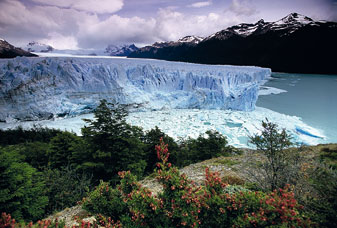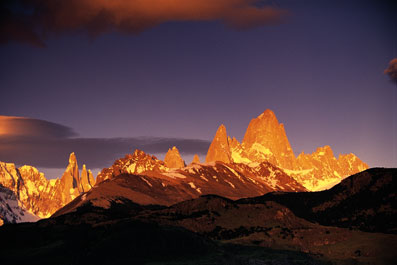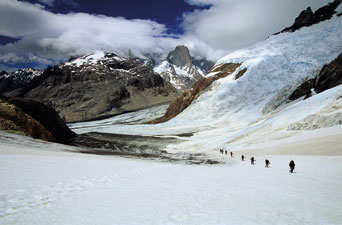


Patagonia : Hielo on the southern mainland
The Lautaro mystery
It is the story of a volcano lost at the far corner of the end of the world. It is an active volcano with a multitude of names. For the first time, a commercial expedition has made an attempt at the summit… lifting the veil a little on the mystery.
TEXTE & PHOTOS: Guillaume Vallot
In the southern hemisphere the Hielo Patagonico Sur is no longer just a name, write the geographers who have remained in their offices. ‘Only’ eight hundred kilometres long, two hundred kilometres wide and eight hundred metres thick, it’s like a very big skating rink… In 2008, the maps sold to tourists provide imprecise information on a mediocre satellite photo background. Numerous peaks here born the name ‘volcano’ but don’t have the slightest volcanic origins. In this way the Fitz Roy was called El Chalten (‘The Volcano’ in Tehuelche (South American Indian language) in days gone by. The cartographical surveys were rare and extended over decades. Sometimes carried out by sailors and sometimes by mountain people, they have generated a chaotic geography conducive to mystery. This is how the Lautaro volcano came into existence.
In 1876, Lord Thomas Brassey, who was exploring the canals under sail, noted a column of ash emerging from the mountain range and named this supposed volcano Humboldt. In 1952, tackling the western sector, an Argentinean expedition believed it had seen a beautiful unknown mountain in the distance and they named it Cerro Lautaro, in homage to the Indian heroes of the independence (1535-1557).
Lliboutry adds to the mix
Later on, following the examination of some aerial photos, an eminent glaciologist identified a rocky outcrop. Lliboutry named his ‘discovery’ Viedma volcano and added it to the highly official list of volcanoes around the world without any kind of validation process. In 1959, the celebrated English explorer Eric Shipton decided to check everything out. However, in Viedma he found only a heap of rocks laid out in an amphitheatre pattern. The shape of the crater had fooled Lliboutry. Returning in 1960, Shipton observed a black ‘wound’ in the ivory white sides of the Cerro Lautaro, from which pressurized steam was escaping. The team marvelled at the sight of an eruption of volcanic ash, which covered the glacier with a fine layer of grey dust. However, a series of broken stoves forced the expedition to beat a retreat without reaching the summit. The latter was scaled in 1964 by Pedm Skvarca and Luciano Pera, who confirmed the intense volcanic activity. In 1973, the British explorer Leo Dickinson counted five fissures at the summit exuding sulphur fumes. Beneath the crust of frost, his feet plunged into smoking mud. In 1998, Frenchmen Bruno Sourzac and Laurence Monnoyeur observed that there was less activity but, frozen stiff, they were nevertheless able to warm themselves up in the wide fissures emitting scorching gas.
A covering of frost
“If I had to give one piece of advice in Patagonia, said Bruno Sourzac having passed through the dusts of El Chalten, it would be to go for it when fine weather is forecast.” Despite the intense collective work, we did wonder if the wall of snow would give way. The squalls crushed the tents where we’d been nestling for two days. Eduardo, our Argentinean guide, remained positive nevertheless saying the storm was nothing out of the ordinary!
A cirrus cloud positioned over the summits, as well as a vertiginous drop in pressure, were both pretty clear signs nonetheless: the Pacific had concocted a fine low to welcome us. At the first sign that the front was on its way out, everybody busied themselves and at noon the following day, the whole team wept with joy. It was a glorious day. Spread across various summits of the Lautaro, we have just observed the improbable let-up in the weather. You could see way into the distance. To the east, the tops of the Fitz-Roy and Cerro Torre. To the west the green channels of the Pacific and their icebergs. One and all have pushed back their physical and mental limits to reach their summits. A southern summit proclaimed to be 3,200 metres, measured 3,505 metres with the GPS, a north summit given as 3,665 m by the altimeter saw the maps offer 3,380 metres... The volcanic activity is dormant. A few sulphuric fumaroles and the infamous scorching mud reminds us of half a century ago, when this living mountain was capable of terrible fits of rage.
Will Lautaro become a classic? We could be tempted to affirm it after the enjoyment the team experienced on the mountain, but didn’t we have a good deal of luck with the forecast? Indeed, this past decade the global warming seems to have slowed the pace and the violence of the Patagonian tantrums. However, the answer to these questions comes only to those who dare to attempt this marvellous adventure…
Read the rest of the article in the Mountain Report magazine - Where to find ?
